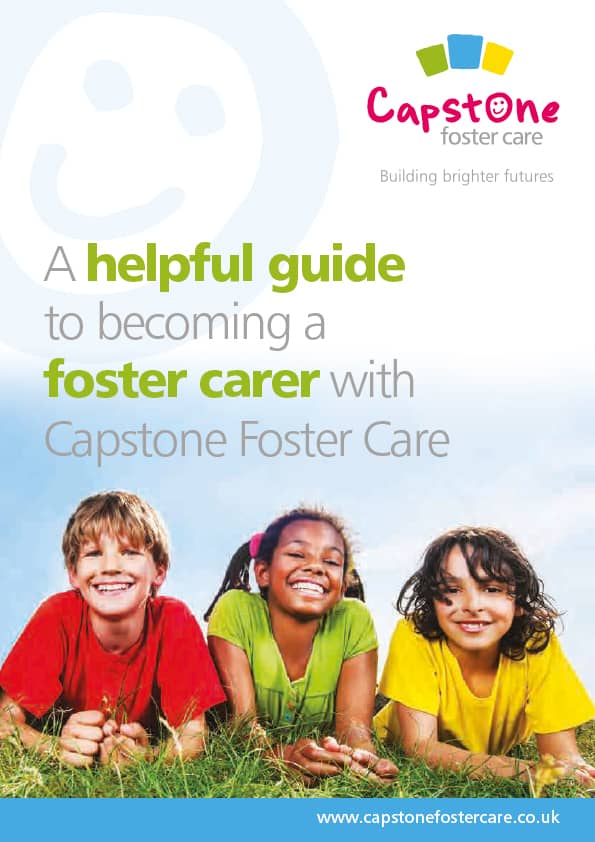


Fostering a disabled child
The role of an independent fostering agency
Can I choose who I foster?
How to foster
What are the benefits of fostering with an independent fostering agency?
What happens when a child is taken into care?
Fostering process: what happens on an initial home visit?
Can you foster if you have mental health issues?
Fostering with local authority vs independent agency
Interview: Life as a foster parent during the pandemic
Becoming A Foster Carer
Benefits of becoming a foster parent
What is a Care Leaver?
What is a Foster Carer?
What is Foster Care?
Do I become a Foster Carer?
Fostering Regulations
How much do Foster Parents get paid?
How to Foster a Child
How long does it take to become a Foster Carer?
How to foster – everything you ever wanted to know
Facts about Foster Care
What are the Foster Care requirements?
Foster Care Handbook
Foster Carer Job Description
Changing IFA - Transferring to Capstone
Fostering Definition
Foster Care Statistics
Fostering Assessment
Fostering Outcomes
Fostering Stories
Fostering Children UK
Children needing Fostering
8 reasons why a child may be taken into care
Fostering as a Career
Looked after Children
Top transferable job skills to become a foster carer
Fostering as a same sex couple
Fostering while renting
Can I foster if...?
Mythbusting the top 10 Foster Care Myths
Can I foster if I am disabled?
LGBT Fostering Mythbusting
Can I foster if I have pets?
Can I Foster A Child?
Can you Foster and Work?
Can you Foster with a Criminal Record
Fostering as a Single Parent
LGBT Family and Foster Care
Fostering across Cultures
Muslim Fostering
Christian Foster Care
Sikh
Empty Nest Syndrome and Foster Care
10 things you can do when your Children fly the nest
Can I Foster?
Fostering Babies - Myths
Focusing on Parent & Child Fostering
Fostering Siblings
Fostering Teenagers
Fostering Teenagers - Breaking down the Myths
Fostering Unaccompanied and Asylum Seeking Children
Mother and Baby Foster Placements
Private Fostering
Therapeutic Fostering - Multi-disciplinary Assessment Treatment & Therapy Service (MATTS)
Young Children Fostering Placements
Difference between short and long-term fostering
How to prepare a child for becoming a care leaver
Children who foster: impact of fostering on birth children
How to prepare your home for a foster child
10 tips for foster children’s education
How to prepare your foster child for secondary school
Tips for coping when foster placements end
Tips for foster parents during Coronavirus
What happens if foster parents get divorced?
5 ways to manage Mother’s Day with foster children
Tips for managing foster children’s bedtime routines
How to handle foster child bullying
Fostering allowances and the gender pay gap
Tips for keeping foster children safe online
How to adopt from Foster Care
5 ways to manage Father’s Day with foster children
8 most common fostering challenges
Supporting foster children’s contact with birth families
How to deal with empty nest syndrome
How to recognise signs of depression in foster children
Can you take a foster child on holiday?
Tips and advice on fostering with a disability
10 tips on connecting with your Foster Child
Fostering versus Adoption - What's the difference?
How Fostering can change a future
How to adopt from Foster Care
How to encourage children to read in Foster Care
How to prepare a Foster Child's bedroom
Online grooming - unwanted contact and how to identify it
Reading and storytelling with Babies and young Children
Supporting Children's Learning
Technology and Internet Safety advice
The 20 most recommended books Foster Carers and young people should read
The impact of early childhood traumas on adolescence and adulthood
Tips for coping with attachment disorders in Foster Children
Tips for supporting reunification in Foster Care
Together for a better Internet - Web Safety for Foster Children
What is sexual abuse and sexual violence
Foster Child behaviour management strategies
Foster Parent Advice: What to expect in your first year of fostering
Capstone's twelve tips at Christmas
10 celebrities who grew up in Foster Care
Celebrating our Children and Young People
Could Millenials be the solution to the Foster Care crisis?
Do you work in Emergency Services?
Form F Assessor and Assessment Training
Foster Care Fortnight
Improving Children's Welfare - Celebrating Universal Children's Day
It's time to talk about Mental Health and Foster Care
New Year - New Career - Become a Foster Carer
Promoting the rights and wellbeing of persons with Disabilities
Refugee Week
Young people and Mental Health in a changing world
Young People Charities
If you’re struggling to bond and create that emotional connection with them – try not to worry. It’s likely your new addition to the family has been through a lot in their past – and may take a while to warm up to you. However, there are many things you can do to help build up that connection. Learn our top 10 ways of communicating with children that can help your foster child feel like one of the family and establish trust.
Wondering how to connect with a child in your foster family? A child or young person may feel nervous or unable to communicate with you in the way you’d like at first. This is normal – and it’s all about creating foster relationships between your family and the foster child as well as establishing trust. Learn how to emotionally connect with your foster child with our 10 simple tips:
1. Make time for them
Arguably the most important tip to building your foster relationship – make time for them. And this doesn’t just mean being around when they’re home from school or having your dinner together. It’s important to allocate time for quality bonding – this may be as simple as watching a movie together or venturing out to do an activity. Creating time for them (maybe at the same time each week to establish routine) is a great way to connect with a child and build up your foster relationship.
2. Listen to them
Effective communication with children isn’t just one-sided – ultimately, your foster child will need to communicate with you too, and that can come from listening to them when they want to talk. It may be hard to hear what’s going on in their mind, and the troubles they have encountered before entering your family – but it’s important as a foster parent to listen and respond in the appropriate way. You want them to feel like they can confide in you and that you’re always there to listen to them.
3. Build trust
One of the most important aspects you’ll need to achieve to establish a great foster relationship is trust. This doesn’t come quickly – especially if a child or young person has had a hard past and struggle with trust issues. Trust takes time – but there are some things you can do to try and gain their trust. Telling them something personal about you can help them to feel like they are trusted – but try not to tell them something they can use against you at a difficult time. You could also give them your trust by letting them do certain things e.g. use the computer on their own, walk the dog around the block. These small things will allow them to realise they are trusted, and then hopefully in turn, trust you too.
4. Physical contact
Establishing your emotional connection with your foster child can be enhanced from touch. Children and Young People will have had different experiences so this is something that your Social Worker will support you with. If appropriate, don’t be afraid to give them hugs and hold their hand – letting them know you’re there with physical contact is a way they will in time feel secure with you and let you in. They may have had different experiences of physical contact in the past – and it may take them time to be comfortable; again, always involve your social worker. But letting them know you’re there when they’re ready is important to building up their trust. Just be aware they may not be willing to accept contact straight away – you could possibly start small such as a touch on the hand, or a hand on the shoulder and gauge how they receive it.
5. Praise
Praise, praise, and more praise! Of course, there can be challenging behaviour that should not be positively reinforced; more attempted to be understood. But when they do demonstrate positive behaviour, this should be rewarded. That way, they’ll not only learn how best to control their behaviour, but also see that you are willing to praise them for good behaviour – and your relationship will hopefully improve. Even the smallest achievements should be praised as this will have a great impact on their confidence and self-worth.
6. Cook
Whether it’s their favourite dish, a large chocolate cake for the whole family to devour or quirky experimental cooking to see what you can conjure up, cooking together is a great bonding activity. It gives the foster child a sense of responsibility; the structure of following instructions from the recipe; and gives you a chance to spend time together with a relaxed activity. Children can also feel more willing to communicate in an environment where they are to the side of you as opposed to face to face – as it may be easier for them to talk.
7. Read
Depending on the age of the foster child, you can read to them –or get them to read to you. This not only enhances their reading skills and improve their literature, but also can be a great bonding exercise. Why not read a series of books, such as Harry Potter? That way, this will be an activity they can enjoy and something you can share together until you’ve finished the entire series of books.
8. Share a hobby
This is a great way to communicate with your foster child. Share something each week, or once a month, that you can both enjoy. Really try to understand what they would like to do– this could be something as simple as painting or drawing, or maybe something a little more adventurous like rock-climbing or ice skating. This would depend on the age of your foster child – it’s easier to share a hobby with a teenager or young adult, so this would be a create way to connect with a teenage foster daughter or son.
9. Exercise
Exercising is a great way to not only get them moving, but also connect with your foster child. Again, this is dependent on age – if you have a young child, walks in the park, football in the garden or taking them swimming would be a great way to bond and get them active. If your foster child is a teenager or young adult, you could do yoga, running, countryside walks or attend gym classes such as Zumba or body conditioning classes if they’re interested in fitness.
10. Play games together
Whether it’s throwing a ball around the garden, sitting down with a board game or imaginative play, this is a great way to bond with your foster child. Here you’re not only building on your relationship, but you’re also creating memories that they can hold onto and cherish when they look back on their childhood.
Now you’ve learnt how to communicate with children in a foster family, perhaps you’re wondering, “how can I help a foster child”? If you’re interested in fostering a child, get in touch with a member of our expert team at Capstone Foster Care.
If you’ve got any questions or would like to find out more about fostering with Capstone, fill out the form below.
An experienced fostering advisor from your local area will then be in touch.

Start the conversation today. Our team of friendly advisors are on hand to answer any foster care questions you may have. We can offer you honest and practical advice that can help you decide if becoming a foster carer is the right path for you.


